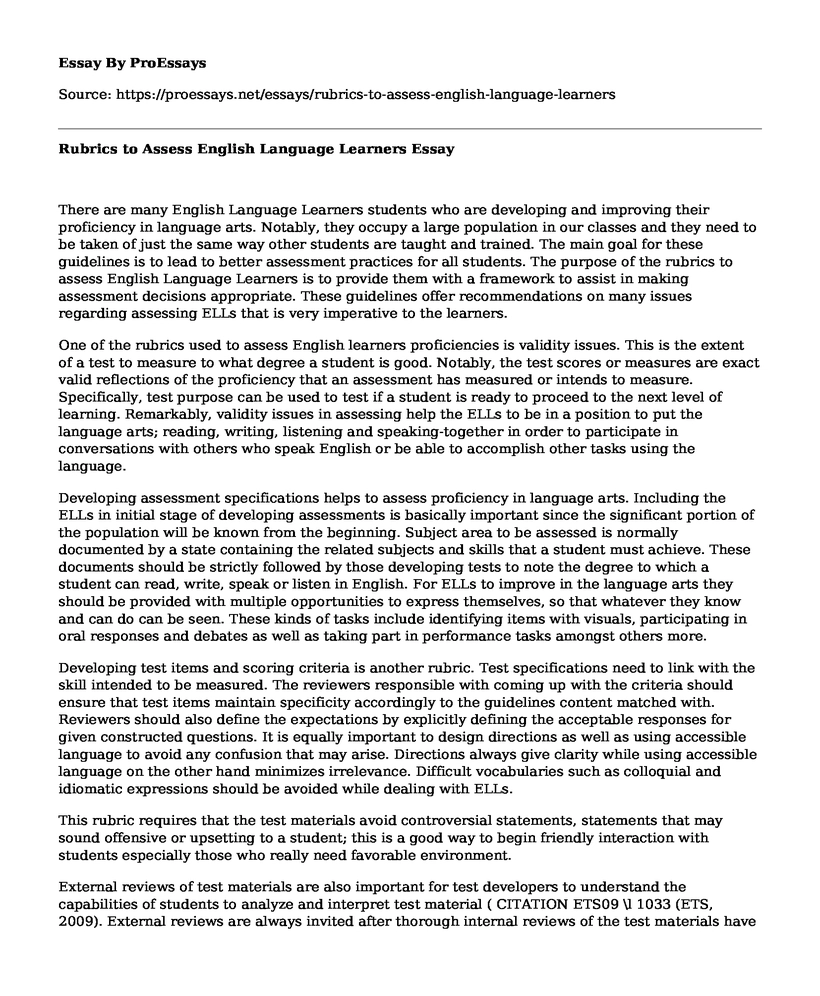There are many English Language Learners students who are developing and improving their proficiency in language arts. Notably, they occupy a large population in our classes and they need to be taken of just the same way other students are taught and trained. The main goal for these guidelines is to lead to better assessment practices for all students. The purpose of the rubrics to assess English Language Learners is to provide them with a framework to assist in making assessment decisions appropriate. These guidelines offer recommendations on many issues regarding assessing ELLs that is very imperative to the learners.
One of the rubrics used to assess English learners proficiencies is validity issues. This is the extent of a test to measure to what degree a student is good. Notably, the test scores or measures are exact valid reflections of the proficiency that an assessment has measured or intends to measure. Specifically, test purpose can be used to test if a student is ready to proceed to the next level of learning. Remarkably, validity issues in assessing help the ELLs to be in a position to put the language arts; reading, writing, listening and speaking-together in order to participate in conversations with others who speak English or be able to accomplish other tasks using the language.
Developing assessment specifications helps to assess proficiency in language arts. Including the ELLs in initial stage of developing assessments is basically important since the significant portion of the population will be known from the beginning. Subject area to be assessed is normally documented by a state containing the related subjects and skills that a student must achieve. These documents should be strictly followed by those developing tests to note the degree to which a student can read, write, speak or listen in English. For ELLs to improve in the language arts they should be provided with multiple opportunities to express themselves, so that whatever they know and can do can be seen. These kinds of tasks include identifying items with visuals, participating in oral responses and debates as well as taking part in performance tasks amongst others more.
Developing test items and scoring criteria is another rubric. Test specifications need to link with the skill intended to be measured. The reviewers responsible with coming up with the criteria should ensure that test items maintain specificity accordingly to the guidelines content matched with. Reviewers should also define the expectations by explicitly defining the acceptable responses for given constructed questions. It is equally important to design directions as well as using accessible language to avoid any confusion that may arise. Directions always give clarity while using accessible language on the other hand minimizes irrelevance. Difficult vocabularies such as colloquial and idiomatic expressions should be avoided while dealing with ELLs.
This rubric requires that the test materials avoid controversial statements, statements that may sound offensive or upsetting to a student; this is a good way to begin friendly interaction with students especially those who really need favorable environment.
External reviews of test materials are also important for test developers to understand the capabilities of students to analyze and interpret test material ( CITATION ETS09 \l 1033 (ETS, 2009). External reviews are always invited after thorough internal reviews of the test materials have been carried out; they provide insights that complement at the same time improving the work done by the internal reviewers. This is to help determine the appropriateness of the items selected if they suit the student's level. External reviewers should ascertain that the purpose matches the specifications of the assessments. They should also ensure that the directions and the task presented on board are clear and appropriate. Fairness and sensitivity in this guideline should be established. Additional assessments for English Language Learners are important; they improve the basic skills these students have. These assessments provide in-depth information about how proficiency can be increased. It also provides insights to inform how instructional planning takes place. For instance, Idea Proficiency Test (IPT) measures overall language proficiency on vocabulary, speech, written language and listening. These tests intonation, stress, accent and syllable structure. Secondary Level English Proficiency measures how to understand both spoken and written English. The results of these kinds of tests help in making placement decisions, making instructional decisions and evaluating the suitable programs that are relevant for ELLs. Peabody Picture Vocabulary test is a reflection of how a student is receptive to English vocabulary and scholastic suitability. This test can be used alternatively with other forms of assessment since they require specialized training which can be too much to students if they are more often.
Assessment adaptations for ELLs need to have high expectations. Factors such as time, level of support, difficulty of the task, product type-verbal or a demonstration and the degree of active participation should be included.
In conclusion, these guidelines are recommended for test developers to their students to improve their proficiency in language arts. Test administration, scoring criteria and the use of external reviews are just among the developed rubrics that are often used.
References
ETS. (2009). Guidelines for the Assesment of English Language Learners. Retrieved FEB 15, 2016, from http:www.ets.org/s/.../ell_guideliness.pdf
Cite this page
Rubrics to Assess English Language Learners. (2021, Mar 08). Retrieved from https://proessays.net/essays/rubrics-to-assess-english-language-learners
If you are the original author of this essay and no longer wish to have it published on the ProEssays website, please click below to request its removal:
- Personal Request of a Better Grade
- Relation Between Language and Power in the Mediterranean and Europe Essay
- Method of Multiple Choice in Education Paper Example
- Compare and Contrast Essay on Online Versus Face-to-Face Learning
- Essay Example on Bilingualism: Benefits, Myths & Misconceptions of Raising Bilingual Kids
- Paper Example on Teaching Success: Managing Classroom Env to Maximize Student Performance & Behavior
- Free Essay Example on Literature Circles: Enhancing Students' Literature Knowledge







